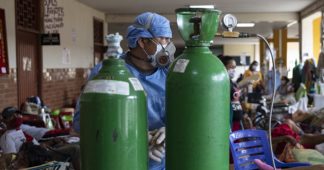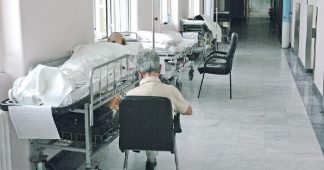By Gary Joad
22 May 2020
Even as American deaths from COVID-19 exceed 90,000 and frontline health care workers are needed more than ever, hospitals and other medical facilities, guided by market forces, are closing or laying off large sections of their workforces.
The US Commerce Department reported at the end of April that health care spending by consumers had dropped by 18 percent during the first quarter of 2020. This is the largest drop since records began in 1959, contributing substantially to the annualized 4.8 percent decline in US gross domestic product. Morgan Stanley forecasts a breathtaking 37.9 percent decline in GDP during the second quarter.
In an interview published May 6 by Health Day News, Dr. David Shulkin, the former secretary of Veteran Affairs and former president and CEO of New York’s Beth Israel Medical Center, said the health care industry lost an estimated $500 billion in revenue during the first three months of the year, with the average hospital losing 40 to 50 percent of their revenues.
The lockdowns imposed in response to the COVID-19 pandemic have taken away some of hospitals’ biggest moneymakers, such as elective surgeries, diagnostic tests and other procedures. According to the Health Day News article, hospitals in Ohio lost $1.3 billion in one month, while hospitals in Virginia lost $600 million.
Rural hospitals, in particular, have been hard hit by the drops in revenue. Prior to the current financial crisis, 172 rural hospitals had closed since 2005, with 12 closures so far this year, according to the North Carolina Rural Health Research Program.
Moreover, patients have increasingly avoided hospital emergency rooms, fearing they could become infected by the virus, despite the dire nature of their illnesses or injuries requiring emergency treatment.
Despite the fact that hospitals have come nowhere near to providing enough personal protective equipment (PPE) to protect their workers, purchasing any additional PPE constitutes an additional financial strain. Due to the bidding wars incited by the White House, hospitals have been forced to spend up to 1,200 percent more for protective materials and ventilators than before the COVID-19 pandemic.
According to Shulkin, the federal stimulus programs passed so far will only cover about 35 percent of the revenues lost by the health care industry in the first three months of the year.
“The rest will need to come from hard decisions that hospitals are going to need to make,” Shulkin told Health Daily News.
The reopening of hospitals for elective surgeries and other procedures will bring in additional revenue, but this is not expected to last long, especially once the second wave of infections hits the US.
“If we see a second wave or resurgence of infections, we’re going to have to go right back to stopping some of those elective activities, and that’s going to hurt hospitals and health providers further,” said Shulkin.
In response, health providers have sought to cut costs, especially through the furloughing or laying off of workers. At least 200 hospitals have furloughed and cut their work forces, with many jobs done away with permanently.
For example, the Mayo Clinic, based in Rochester, Minnesota, announced a $1.4 billion pay cut to its 30,000-person workforce, with fewer hours and furloughs, after experiencing a $3 billion drop in revenue. Health Partners (HP) of Bloomington, Minnesota, which employs some 1,800 physicians in the Twin Cities region, furloughed 20 percent of its staff. Anticipating a loss of $160 million by the end of June, UK HealthCare, a series of hospitals associated with the University of Kentucky, recently placed 1,700 workers on “no-pay status,” allowing employees to exhaust vacation and sick pay before filing for unemployment.
According to the Bureau of Labor Statistics, 43,000 health care workers lost their jobs in March, while 1.4 million more lost their jobs in April. The majority were workers at dental practices, doctors’ offices, and other small providers, but there was also a jobs massacre at hospitals overrun with COVID-19 patients.
In Detroit, Beaumont Health is laying off nearly 2,500 hospital workers, while Detroit Medical Center furloughed 480 employees. The Henry Ford Health System announced the furloughing of some 2,800 workers in its six hospitals located across the Detroit metro area.
Integris Health of Oklahoma, which operates 19 hospitals, completely closed a hospital in Oklahoma City, furloughed the employees and suspended contributions to their retirement funds.
The Medical University of South Carolina laid off 900 workers, while asking the remaining staff to accept a 15 to 20 percent cut in pay. Mercy Health of Ohio, citing revenue losses exceeding $100 million in a month, cut 700 jobs, while Essential Health of Minnesota has laid off 500 workers.
According to the Associated Press, two health systems in Virginia reported losses of $600 million in 30 days and furloughed 1,000 workers.
Tricia Newman, a representative from the Kaiser Family Foundation, told the Associated Press that the layoffs “may be in areas where there will be growth in the virus, which makes the layoffs particularly alarming, because hospitals are gearing up or should be gearing up even in places where coronavirus is not an emergency as it is in other parts of the country.”
The layoffs have included many nurse anesthetists, professionals skilled in intubation and ventilator management for the seriously ill COVID-19 victims needing care in an intensive care unit (ICU).
A contract ICU nurse in Oklahoma told ABC News that he was dismissed while he was donning his scrubs in the hospital’s dressing room. “It took me by surprise because we were super busy in the ICU trying to save lives,” he said.
Similarly, Michelle Sweeny, a nurse working for Atrius Health as a case manager in Plymouth, Massachusetts, was given only four hours’ notice that she had been furloughed, giving her a short period of time to notify her chronically ill patients that she would no longer be seeing them.
“It’s very devaluing, like a slap in the face,” she told National Public Radio. “I have never been unemployed my entire life.”
At University of Cincinnati Medical Center, Fae-Marie Donathan, a surgical ICU nurse, expected she would remain working when she was informed of her layoff. She told NPR that she took home about $1,100 every two weeks, but that her last net pay was $46.
In April, the Emergency Nurses Association (ENA) created a relief fund for nurses experiencing hardship from coronavirus layoffs. The assistance, however, is limited to a one-time individual relief grant of $599.
“It’s disheartening to see frontline health care workers being laid off and furloughed,” Dr. Jay Bhatt, a Chicago internist, told ABC News. “I’ve seen my colleagues and friends proud to be health care workers, on the frontlines of unemployment who are anxious about how this will impact themselves and their families.”











